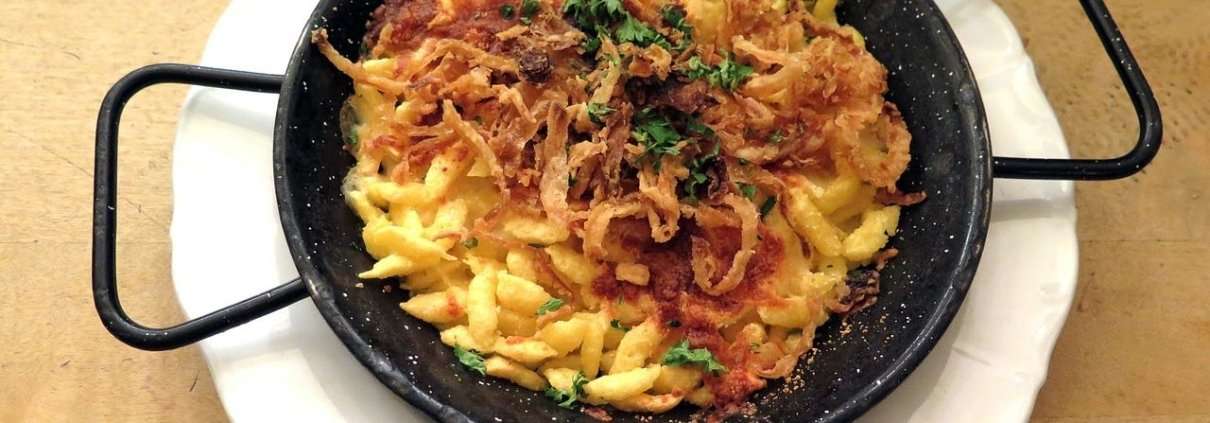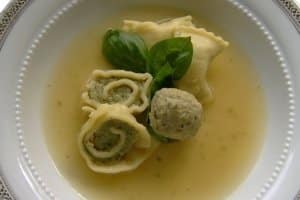Local Swabian Food
Swabian food is simple, hearty fare that relies on ingredients that were historically available in every season. That’s why there are so many dishes based on meat and home-made egg noodles. Today many chefs have created vegetarian versions of some of these classics, but they remain stick-to-your-stomach filling.
We’ve chosen to highlight the dishes that are most recognizable as Swabian, all of which remain popular in Stuttgart to this day.
Maultaschen
Maultaschen are perhaps the most distinctively Swabian dish. They are essentially large ravioli, traditionally filled with meat, onions and spinach. They are variously served in a savory beef broth, pan-fried, steamed, or cut up over a salad. Modern versions include maultaschen served burger style and vegetarian spinach-and-cheese maultaschen.
Maultaschen have an irreverent history. It seems they were invented by the monks of Maulbronn Monastery as a way of circumventing the ban on eating meat during Lent. Supposedly God would only see the noodle “purses” and not notice the meaty filling... or at least wink at it.
Käsepätzle
Spätzle are noodles made from a simple viscous dough of flour, egg and water. The dough might be scraped in small pieces into a pot of boiling water, or squeezed through a special press also known as a spätzle.
Käsespätzle is nothing like your typical American “mac & cheese.” The fresh-made noodles are layered into a casserole with caramelized onions and grated Emmental cheese, then baked in the oven. It’s often topped with crispy fried onions, as pictured here.
Linsen & Spätzle
This dish is as simple as its name: lentils are soft-boiled with vinegar then served over the traditional Swabian egg noodles: spätzle. It is a favorite during the long cold months in Stuttgart.
For the meat lovers, a couple of long Saiten sausages are usually served on top. For good measure, a large slice of Rauchfleisch, smoked pork belly, may be added as well.
Zwiebelrostbraten
Directly translated as “onion roast,” this roast beef is cooked in a rich gravy flavored with garlic and of course, onions. Although the dish is not unique to Swabia, here it is usually served with the local spätzle or fried potatoes. It is traditionally served for Sunday dinner, but you can try it in any Swabian restaurant.
Gaisburger Marsch
Stew up some ox meat in broth, boil some potatoes and spätzle, and you have a thick stew fit for a ... soldier! Here’s how the story goes: the stew got its start in Gaisburg, now a district in Stuttgart. It was so popular among soldiers that even remotely stationed men were willing to make the long march back to Gaisburg to enjoy it. Fortunately today it’s available all over the region, so no marching is necessary.
Schupfnudeln
Although spätzle are by far the most popular form of Swabian pasta, schupfnudeln are quite special to the region. The dough is made half from normal wheat flour and half from potato flour, in addition to egg and water. This is an example of cost-saving efforts: when people ran out of flour, they made do with potatoes.
The name schupfnudeln comes from the rolling motion use to create the finger-sized pieces. They can be first boiled or else directly pan-fried. Schupfnudeln are commonly served with sauerkraut, as pictured here.
Saure Kutteln
As with so many regional specialities, Saure Kutteln is a dish that was once a way of eating very economically. Literally translated as “sour tripe,” it is made from rumen, one of the stomachs of a cow. The tripe is sliced, fried in butter, and dusted with flour. Then it is cooked in a sauce made sour with wine and/or vinegar and traditionally flavored with bay laurel, juniper, and pepper.
Laugengebäck
Everyone associates Brezeln, pretzels, with Germany. However, you might be surprised to learn that “Brezel” describes only the shape – the signature looped knot. These large soft pretzels are sold with butter smeared inside the largest curve, topped with cheese and bacon, and around deli sandwiches.
More broadly, all “pretzel dough” baked goods are called Laugengebäck. They come in a huge range of shapes, each with their own name (prefaced with Laugen-). The crackly exterior and soft chewy inside makes them understandably popular at any time of day.









